Learn how to make soft gluten-free flatbread perfect for pita, wraps, naan, sandwiches, flatbread pizza, and more! This easy, one bowl recipe cooks in minutes on the stove top with a doughy, fluffy texture, fooling anyone it’s both gluten-free and vegan! The trick? Using a two simple ingredients boosts the dough’s elasticity, making it easy to shape, roll, and extra soft!
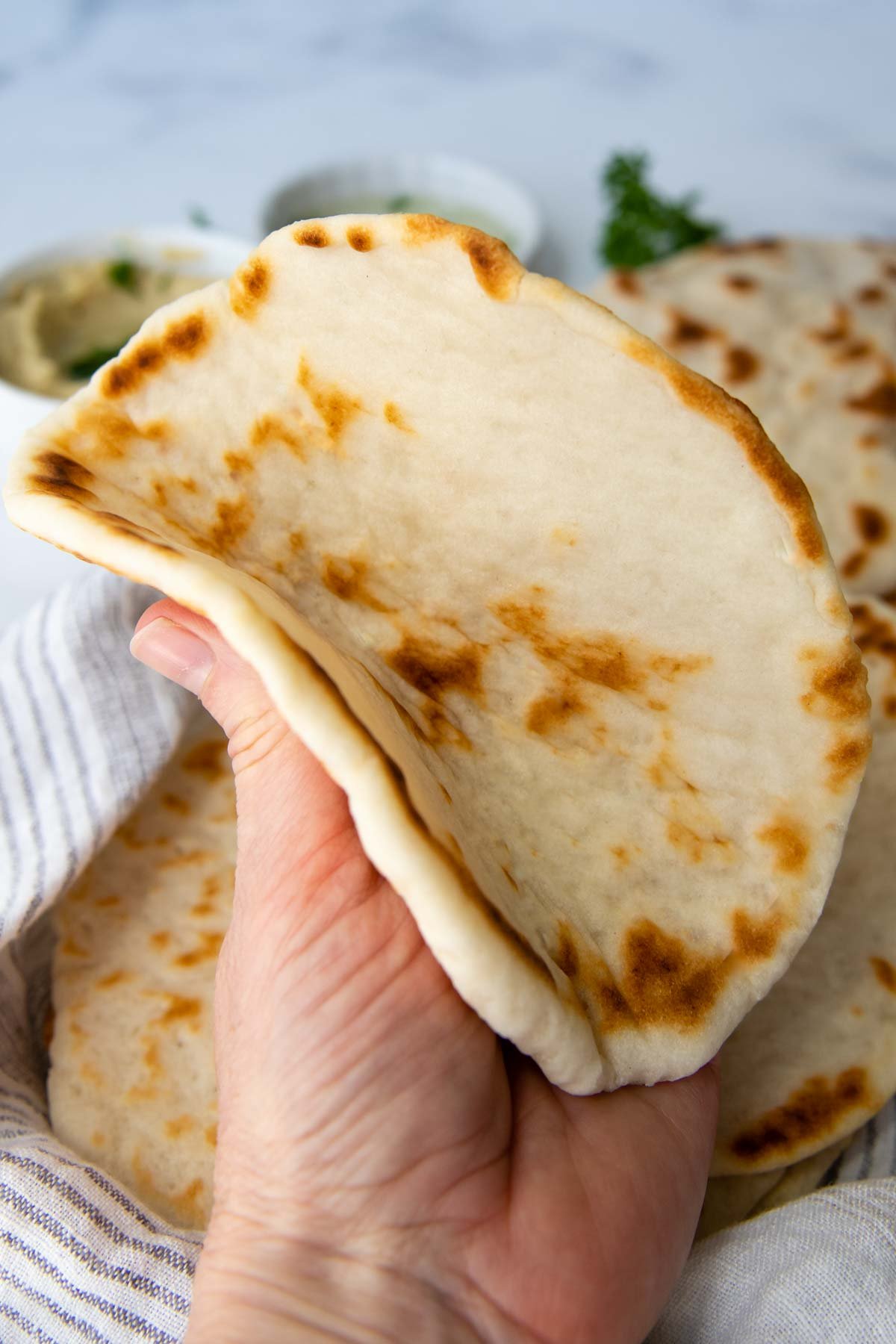
Gluten-Free flatbread recipe
As my collection of essential gluten-free bread recipes grows, there are less and less limits for those on a gluten-free diet to live without. This gluten-free recipe for flatbread makes no exception, with an extra soft texture and easy, fuss-free prep!
What makes this GF flatbread stand above the rest? Employing one of my favorite gluten-free baking tricks! A simple, affordable ingredient, psyllium husk powder, builds the dough’s elasticity and yields a soft texture as it helps absorb excess moisture.
Furthermore, replacing a small amount of gluten-free flour with a little potato starch is a trick I use with gluten-free rolls to help build structure without adding additional flour, which dries out the texture.
You are left with soft, pliable gluten-free flatbread (which works interchangeably for GF naan bread or pita) that even the most novice cook / baker can pull off! This simple one bowl recipe mixes up in minutes, requires one rise, and the dough is very easy to roll out.
Now you can enjoy a gluten-free flatbread pizza with ease or use to serve alongside soups, salads, dips, or as a sandwich wrap!
Ingredient Notes
Since gluten-free flatbread pita uses no dairy or yogurt, those on a plant-based or dairy-free diet can enjoy as well. Below are the recommended ingredients, along with how they affect the recipe and any workable substitutions.
If you would like to add more complex taste, stir in garlic powder or oregano to the mixture. Alternatively, after cooking brush on olive oil, then sprinkle with sea salt, fresh parsley, or parmesan cheese for added flavor.
- Gluten-free flour – I use and recommend Cup4Cup gluten-free flour blend for the softest texture. However, this blend does contain milk powder. For a dairy-free, vegan recipe, use King Arthur Measure-for-Measure or your preferred brand.
- Potato starch (not flour) – Instead of relying on additional flour to structure the dough, I substituted another gluten-free starch for added softness. Use potato starch for best results, but tapioca starch may be substituted.
- Psyllium Husk Powder – An essential gluten-free binding agent ingredient for any dough that requires shaping, such as naan or gluten-free burger buns. It helps help mimic the elasticity and crumb structure of wheat baked goods.
- Active Dry Yeast – Activate the yeast by mixing together with the warm water and a little sugar. If using instant yeast, this step may be omitted and add the yeast with the dry ingredients.
- Baking powder – Helps add rise and loftiness as it cooks on the stove top. I like using a combination of baking powder and yeast to help with lift in GF breads.
how to make Gluten-Free Flatbread
(Below shows step-by-step photos and modified instructions. For the complete recipe, along with ingredient amounts, scroll down to the recipe card.)
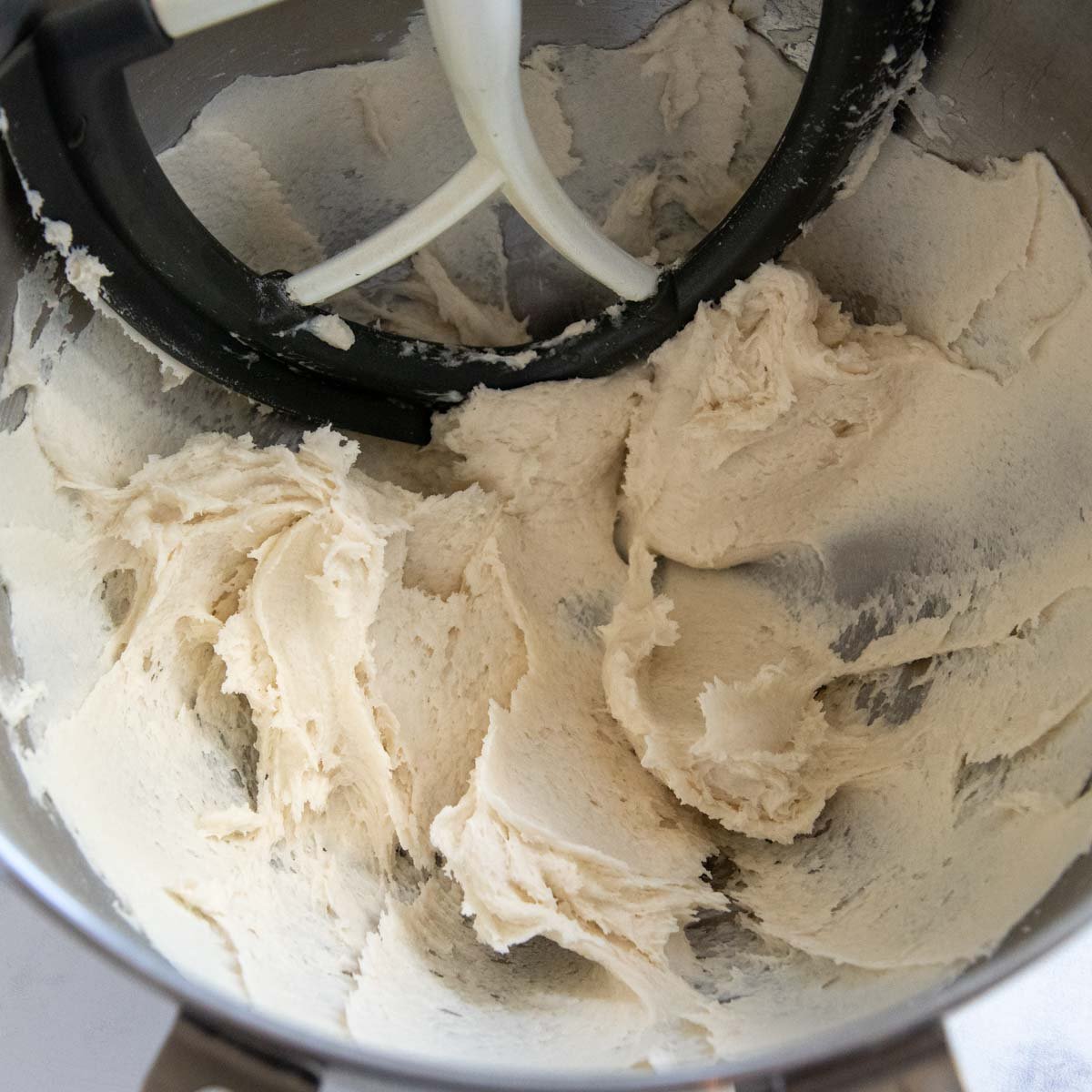
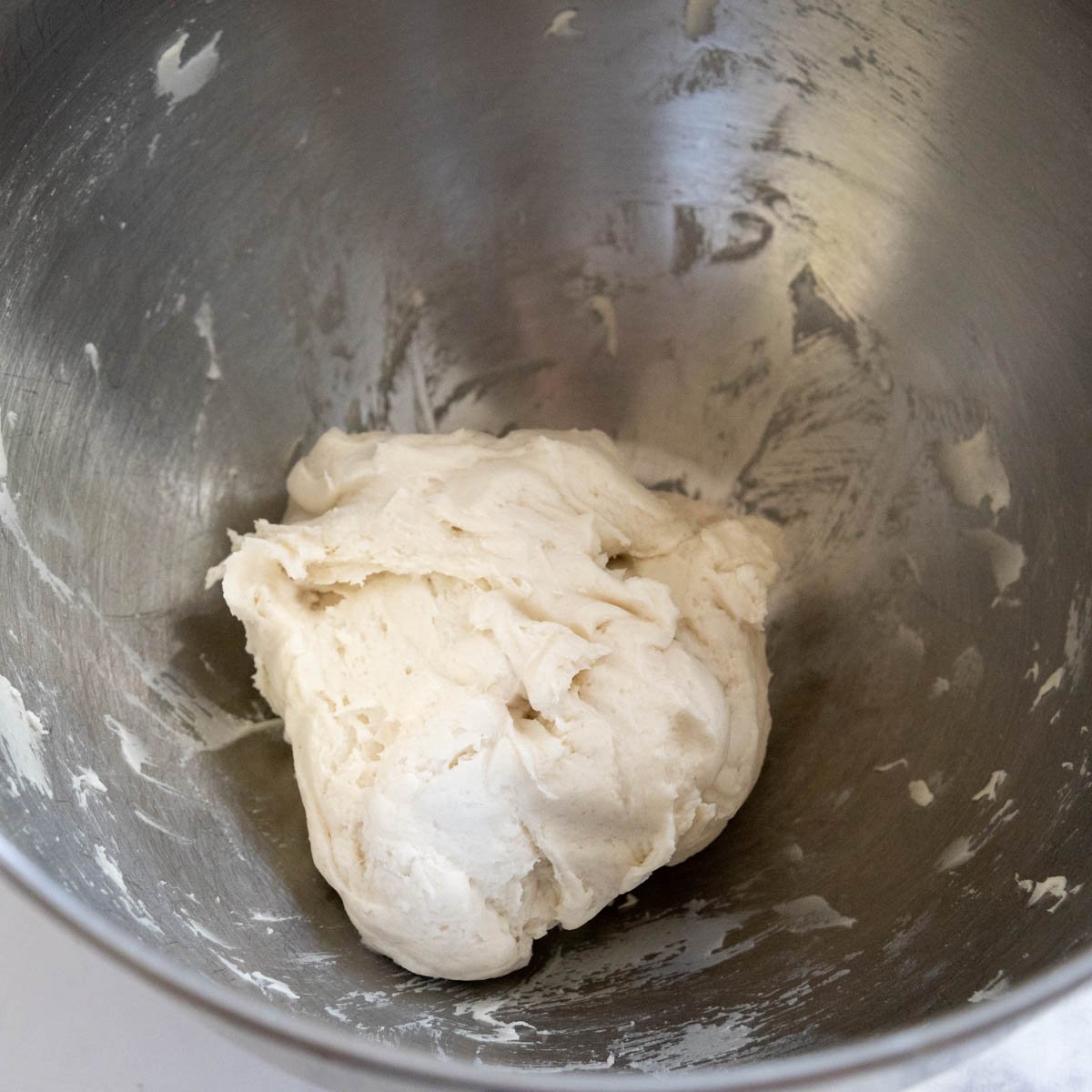
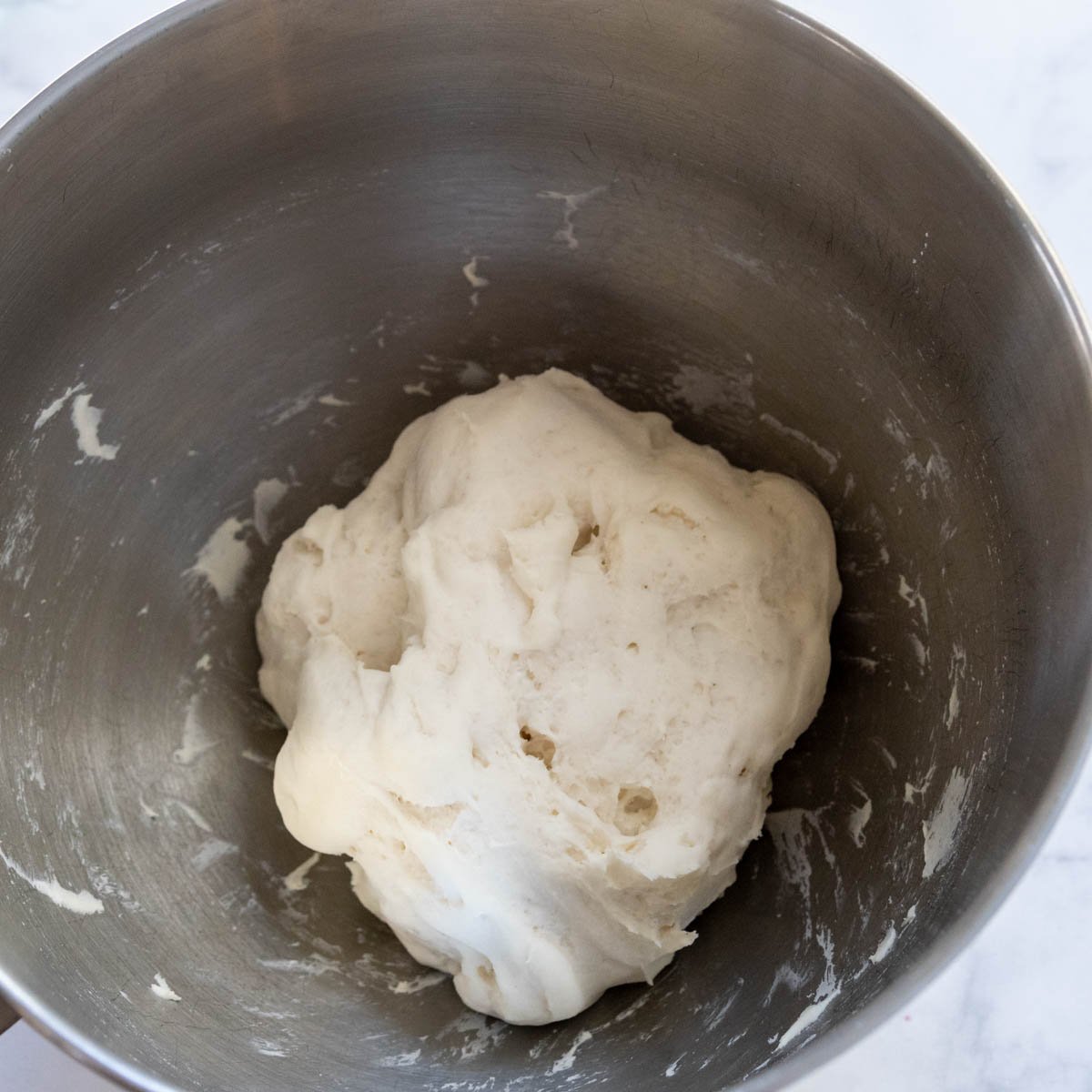
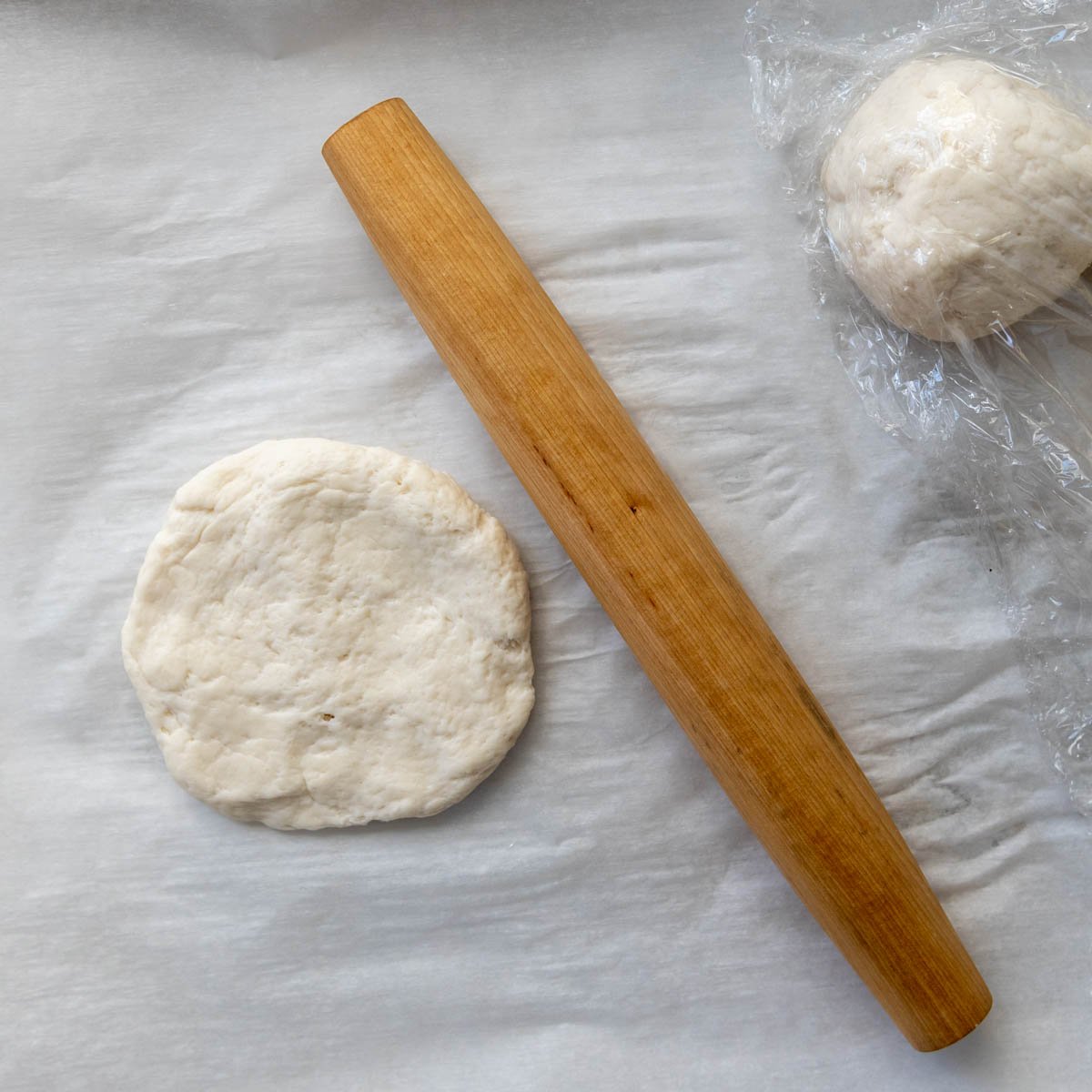
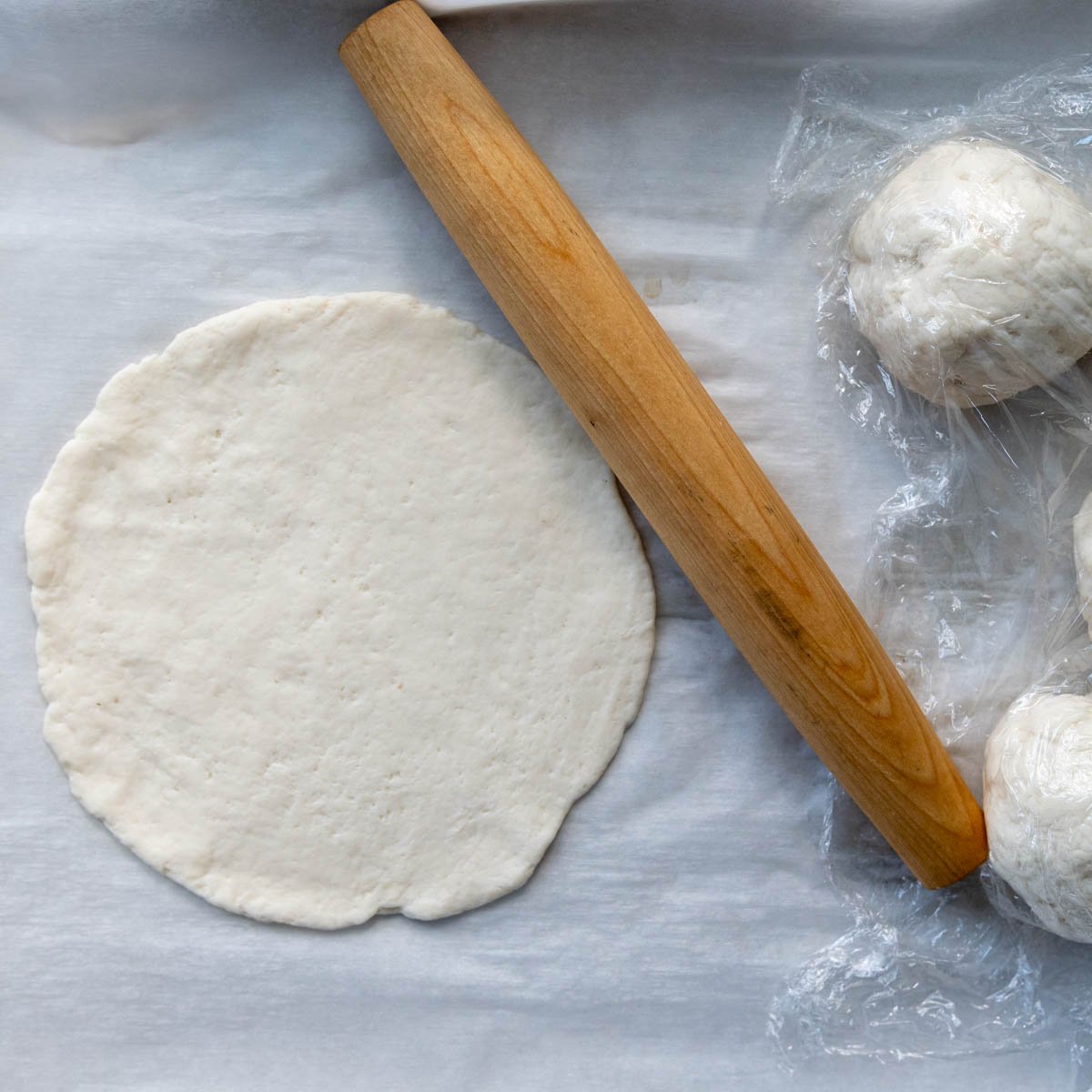
- Begin by heating the oven to 150ºF. Once it reaches temperature, turn it off. This will serve as an extra warm place for the dough to rise.
- In a small bowl combine the warm water, yeast, and sugar. Whisk and set aside for 5 minutes to activate. When ready it will be frothy on top.
- In a large bowl of stand mixture with paddle attachment, combine the gluten-free flour, potato starch, psyllium husk, salt, and baking powder. Mix on low speed.
- Add in the yeast / water mixture and oil. Mix on medium speed for 3 minutes. If you do not have a stand mixer, mix with a wooden spoon to combine well.
- Scrape the dough into the middle of the bowl. Cover with plastic wrap and place in the warm oven, leaving the door slightly ajar for 5-10 minutes before closing. Let rise for 45 minutes.
- When read to shape, pour a little additional olive oil to dip your fingers in if the dough sticks. Place a large sheet of parchment paper on a workspace. Use slightly greased fingers to divide the dough into 5 equal-sized balls. Cover with plastic wrap and let rest for 10 minutes.
- Meanwhile, heat a dry nonstick skillet over medium heat.
- Move the balls to the side, keeping covered. On the other side spread a very, very light sheen of olive oil. Place one ball in the middle and flatten into a thick disc. Use a rolling pin to shape into a 6½-inch circle, rotating quarter turns as you roll to maintain a round shape.
- Use a spatula to lift the flatbread onto the hot skillet. Cook, undisturbed, for 1½ – 2 minutes, flip, and cook for an additional 1½ – 2 minutes. Make sure to cook just as long on second side, or they will be dense and not as fluffy (even if they look “done.”) As the flatbread cooks, roll out the next one.
- Transfer to a clean, lint-free kitchen towel and cover to keep warm as you roll and cook remaining flatbreads. Serve immediately.
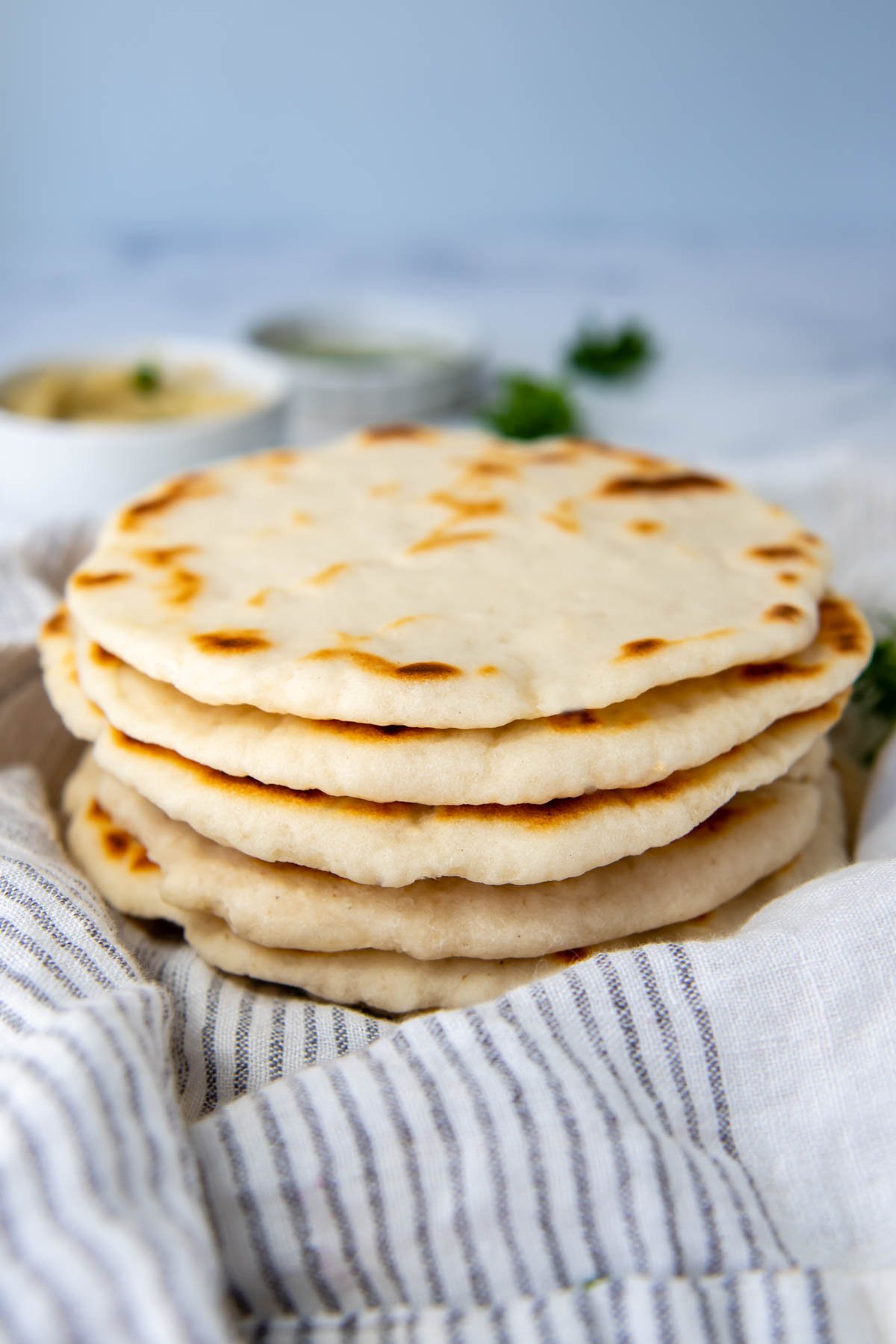
Gluten-free Flatbread Pizza and other uses
Now that you have a solid, easy recipe, there are many ways to enjoy it! Use as you would for gluten-free pita or naan, with dips, hummus, or served alongside gluten-free curry. Flatbreads can also be used similar to gluten-free tortillas, for wraps or to fill with chicken salad, tuna salad, or lunchmeat and veggies.
To make a gluten-free flatbread pizza crust, prepare and cook as directed. Spread with tomato sauce, cheese, and desired toppings. Place on a baking sheet or pizza stone and bake in a 425ºF oven for 5-8 minutes, or until the cheese is bubbly.
Alternatively you may also use this recipe to make gluten-free grilled pizzas! See the linked post for step-by-step directions.
Using Psyllium for Soft Texture
In traditional wheat flour recipes, gluten acts as a binder, creating elasticity in the dough and soft texture once it bakes. Gluten-free recipes, especially breads, need something to mimic the elasticity and bind the starches.
I’ve become such a proponent of using psyllium husk in gluten-free baking because it also readily soaks up excess moisture, something GF starches don’t do well on their own. Some recipes compensate this by adding extra flour, but this yields a dry, crumbly texture.
Although it’s an extra ingredient to buy, it’s rather affordable and will elevates the texture and crumb to something hard to believe is gluten-free! Although there are a lot of brands, I recommend buying a lighter-colored psyllium as to not change the color of your baked goods.
How to STore, Freeze, and Reheat
If you are not enjoying all the flatbreads at once, cool completely on a wire rack. Transfer to airtight container and store at room temperature up to 24 hours. I recommend using within a day for optimal freshness, or otherwise freeze.
To freeze, stack between pieces of parchment paper, paper towels, or wax paper. Wrap securely with plastic wrap and transfer to a ziplock freezer bag. Freeze up to 2 months.
When ready to serve, they are best served slightly warm. Defrost at room temp, wrap in a paper towel and microwave for 15 seconds to slightly rewarm.
Click here to see the
step-by-step web story instructions for this recipe!
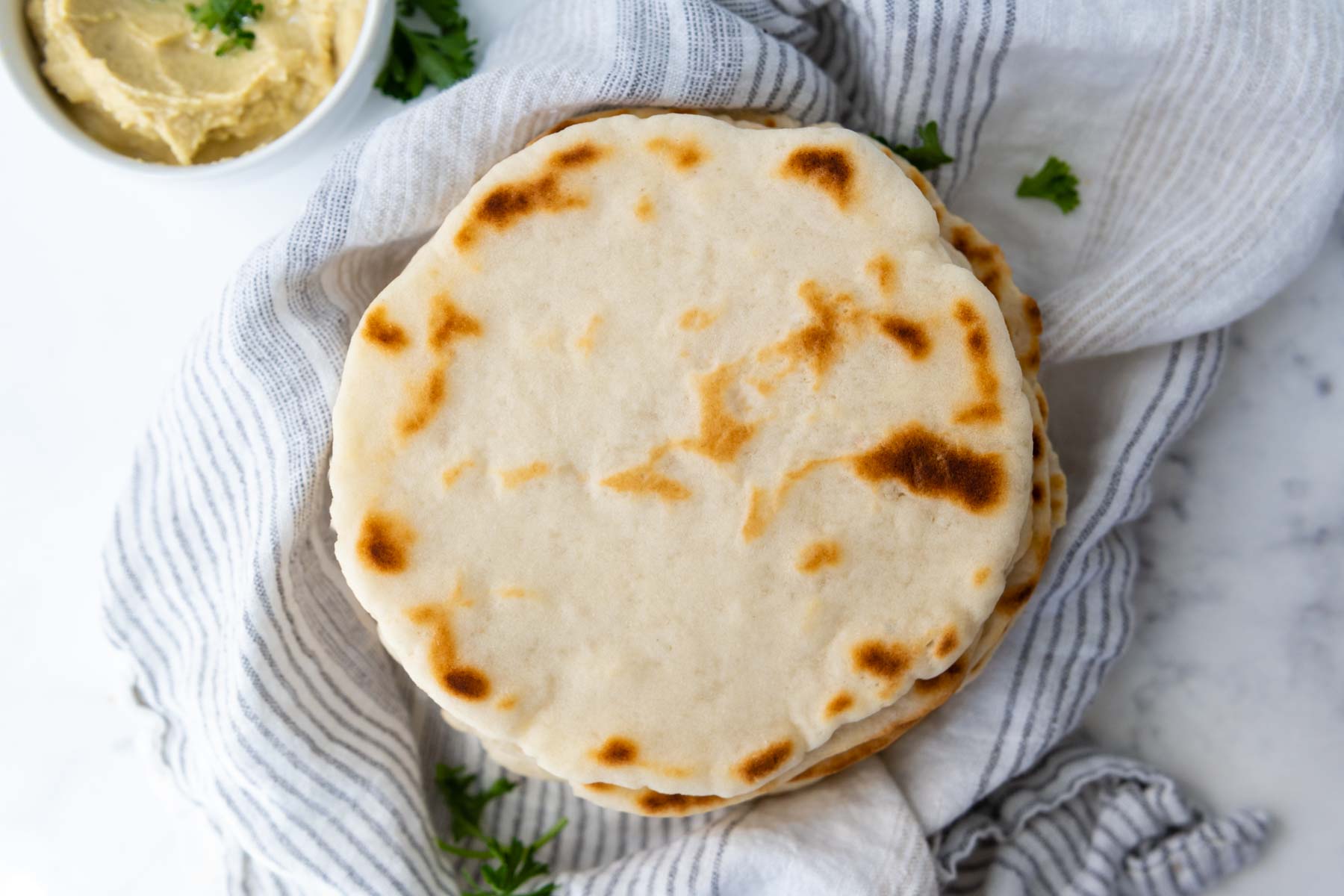
Save this recipe for gluten-free flatbread to your pinterest board!
Let’s be friends on Pinterest! I’m always sharing great recipes!
Soft, Fluffy Gluten-Free Flatbread (Extra Easy)
Listen to Recipe Audio
Ingredients
- ¾ cup (180 g) warm water heated to 110℉
- 1 teaspoon (5 g) active dry yeast
- 1 teaspoon granulated sugar
- 1⅓ cup (192 g) gluten free all purpose flour (I recommend Cup4Cup GF flour, see recipe notes for dairy-free)
- 3 tablespoons (31 g) potato starch
- 2 teaspoons (7 g) psyllium husk powder
- ¾ teaspoon baking powder
- ½ teaspoon salt
- 1 tablespoon (14 g) olive oil and more for shaping and rolling
Instructions
- Begin by heating the oven to 150ºF. Once it reaches temperature, turn it off. This will serve as an extra warm place for the dough to rise.
- In a small bowl combine the warm water, yeast, and sugar. Whisk and set aside for 5 minutes to activate. When ready it will be frothy on top.¾ cup (180 g) warm water,1 teaspoon (5 g) active dry yeast,1 teaspoon granulated sugar
- In a large bowl of stand mixture with paddle attachment, combine the gluten-free flour, potato starch, psyllium husk, salt, and baking powder. Mix on on speed.1⅓ cup (192 g) gluten free all purpose flour,3 tablespoons (31 g) potato starch,2 teaspoons (7 g) psyllium husk powder,¾ teaspoon baking powder,½ teaspoon salt
- Add in the yeast / water mixture and oil. Mix on medium speed for 3 minutes. If you do not have a stand mixer, mix with a wooden spoon to combine well.1 tablespoon (14 g) olive oil
- Scrape the dough into the middle of the bowl. Cover with plastic wrap and place in the warm oven, leaving the door slightly ajar for 5-10 minutes before closing. Let rise for 45 minutes.
- When read to shape, pour a little additional olive oil to dip your fingers in if the dough sticks. Place a large sheet of parchment paper on a workspace. Use slightly greased fingers to divide the dough into 5 equal-sized balls. Cover with plastic wrap and let rest for 10 minutes. Meanwhile, heat a dry nonstick skillet over medium heat.
- Move the balls to the side, keeping covered. On the parchment spread a very, very light sheen of olive oil. Place one ball in the middle and flatten into a thick disc. Use a rolling pin to shape into a 6½-inch circle, rotating quarter turns as you roll to maintain a round shape.
- Use a spatula to lift the flatbread onto the hot skillet. Cook, undisturbed, for 1½ – 2 minutes, flip, and cook for an additional 1½ – 2 minutes. Make sure to cook just as long on second side, or they will be dense and not as fluffy (even if they look "done.") As the flatbread cooks, roll out the next one.
- Transfer to a clean, lint-free kitchen towel and cover to keep warm as you roll and cook remaining flatbreads. Serve immediately.
Recipe Notes
Gluten-Free Flatbread PIzza
To make a gluten-free flatbread pizza, prepare and cook as directed. Spread with tomato sauce, cheese, and desired toppings. Place on a baking sheet or pizza stone and bake in a 425ºF oven for 5-8 minutes, or until the cheese is bubbly. For grilled pizzas see how to make gluten-free pizza on the grill.Gluten-Free Flour
I use and recommend Cup4Cup gluten-free flour for the softest texture. However, this blend does contain milk powder. For a dairy-free, vegan recipe, use King Arthur Measure-for-Measure or your preferred brand. If using King Arthur Measure-for-Measure flour, make these adjustments:- Measure 1 ⅓ cup KA flour, then remove 2 tbsp. Replace with 2 tbsp. cornstarch.
- Use a little more oil when rolling out to add a touch more fat / moisture.
- Cook less. I found the best results when cooking 1 minute / side versus 1 ½-2 minutes.
Storing, Freezing, and Reheating
If you are not enjoying at once, cool completely on a wire rack. Transfer to airtight container and store at room temperature up to 24 hours. I recommend using within a day for optimal freshness, or otherwise freeze. To freeze, stack between pieces of parchment paper, paper towels, or wax paper. Wrap securely with plastic wrap and transfer to a ziplock freezer bag. Freeze up to 2 months. When ready to serve, they are best served slightly warm. Defrost at room temp, wrap in a paper towel and microwave for 15 seconds to slightly rewarm.Nutrition
This post contains affiliate links. My opinions are always my own. If you purchase a product through an affiliate link, I make a small commission – at no cost to you. Read full disclosure policy here.

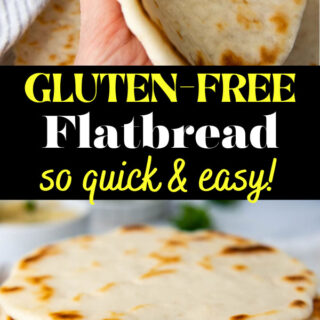
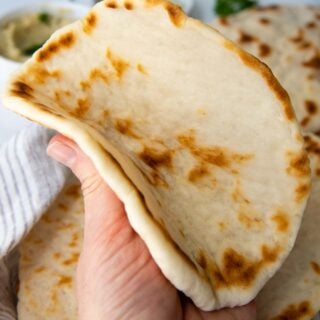
Tyra Moubarak says
This recipe worked so well for me after a few fails with others. I went to Egypt last year and didn’t get to indulge in any of the local balady bread we had with almost every meal (whomp whomp), but because I’ve recently gotten back into Middle Eastern cooking, I decided to try pairing this with the foods from Lebanon, Egypt, Palestine, Syria, etc. It’s such a solid gf bread to compare with Khoubz or Arab flatbread. And I always appreciate a recipe that allows enough time for a decent rise in the dough. I’ve tried others that turned out cracker-like or rubbery, but this puffed up beautifully for me and was still great out of the freezer
Melissa Erdelac says
Hi Tyra,
This is so wonderful to hear! I exubertently enjoy this with Middle Eastern dishes because I have missed out on so long! I’m glad it’s able to make a comeback for you as well!
Best,
Melissa
Nichole says
Just Amazing!! Made these for my son and can’t believe how similar it is to regular wheat flat bread, literally shocked. I didn’t have all the ingredients so I took a risk and used cornstarch instead of potato starch and ground flax seed instead of psyllium husk. Turned out better than I ever imagined. Thank you
Melissa Erdelac says
Hi Nichole,
Thank you so much for sharing your adaptations. I’m so glad that worked out for you!
Best,
Melissa
Travis Huber says
So I made some changes to your Flatbread. I refuse to use premade blends (besides the super food blend) and I hate the psyllium husk flavor. I used the same instructions though!
1/3 cup almond flour
1/3 cup IYA Foods “super food flour”
1/3 cup brown rice flower
1/3 cup buckwheat flour
3/4 cup warm water
1 tsp nutrition yeast
1 tsp yeast
3 tsp xanthan gum
3 tsp potato starch (I meant to use Tbsp but I messed up)
1/2 tsp salt
1 Tbsp olive oil (I used truffle infused olive oil)
Anonymous says
I forgot sugar when I wrote that.
Melissa Erdelac says
Thank you, Travis! This is so helpful for those who need dietary options. Appreciate it!
Best,
Melissa
Anonymous says
For sure! I have family that is nut free and we sub out tiger nut for almond flour
Joyce says
For anyone wondering if substituting with King Arthur Measure for Measure will work, it did not for me. It didn’t rise and it was dry and dense. Looking forward to trying again with Cup 4 Cup flour as written. I have had great success with other recipes on this site using the recommended flour.
Melissa Erdelac says
Hi Joyce,
I appreciate you writing. I’m going to experiment with the KA and see if I can achieve the same results as with the Cup4Cup. I think swapping out a bit of the flour with cornstarch or more potato starch might be the trick! I want readers to have a good dairy-free option, which you would have to use the KA flour for.
Best,
Melissa
Joyce says
Please do let us know how that works. I was wondering if adding cornstarch would work since C4C is mostly cornstarch.
Melissa Erdelac says
Hi Joyce,
I tested the recipe today with KA and had good results. I’ll share what I did here. If you try or someone else can test this out to double check it works, I’ll publish the adaptation in the recipe card.
1. Measure 1 1/3 cup KA flour, then remove 2 tbsp. Replace with 2 tbsp. cornstarch.
2. Use a little more oil when rolling out to add a touch more fat / moisture.
3. Cook less time. I found the best results when cooking 1 minute / side versus 1 1/2-2 minutes.
(If others are having dry results, with a different GF flour try any or all of these things!)
Best,
Melissa
Joyce says
I just tried your tweaks and it worked well. However, I found the dough to be too dry (both this way and without the addition of cornstarch). I didn’t come together in the mixer so this time I added an extra 1/2 Tbls of olive oil and it started to come together with a little help from my spatula. It could possibly have used even a bit more oil. It cooked up nicely (somewhere between 1 and 1 1/2 minutes each side. Now I am wondering if it was the addition of the cornstarch or the extra oil (or both) that made the difference. Anyway, I enjoyed it enough to eat two, so thanks for the recipe 🙂
Melissa Erdelac says
Hi Joyce,
If you find your dough dry, I think adding a little extra oil is a good offset. It will add moisture without over-saturating the dough, making it gummy. I would try to go up to 2 Tbsp. oil or cut back on the flour just a tad, like 2 tbsp. Thanks for the follow up!
Best,
Melissa
Laura says
I am new to baking without gluten. I recently found out I have an allergy to wheat, oats, and rice! Several others but these have been the most life changing. Do you have any recommendations for a flour or flour blend that doesn’t have rice in it? I miss bread and tortillas.
Thank you!
Melissa Erdelac says
Hi Laura, I’m so sorry! This must be so hard. All the most popular brands do contain rice flour. If you can have oat flour, Cup4Cup makes an Ancient Grains flour without rice flour in it. If you can’t have oat flour, I would suggest leaning into almond flour recipes. Here are my top almond flour recipes and included in that list is an almond flour tortilla that I love! Let me know if I can help in any other way!
Best,
Melissa
Nicole says
Can you use xanthan gum instead of psyllium husk powder?
Melissa Erdelac says
Hi Nicole,
No I wouldn’t suggest this, but you can probably use Expandex Modified Tapioca Starch in it’s place. I haven’t personally tried it, but other readers have substituted it for psyllium in other recipes. Hope this helps!
Best,
Melissa
Robyn says
Xanthan gum impacts in the same ways as gluten. White rice also. My cheeks become hot and red. All my muscles cramp and my joints ache. I swell up from head to toe, including my eyelids, digestive tract, legs and feet. I feel feverish as well. This lasts for several days. If I consume these unaware over time, inflammation builds through my entire system and can take months to reduce. This causes permanent damage.
I replace white rice with brown or use a mix of gluten free oat flour and tapioca flour instead. Rice flour tends to be dry.
To some things I add dry, unflavored gelatin to dry ingredients to increase moisture and sturdiness.
I really like this recipe and want to try it. I don’t believe the changes necessary for me to make will ruin this bread. Hopefully, it will turn out well.
Melissa Erdelac says
Hi Robyn,
Ugh, food allergies are the worst! That sounds so difficult. It seems like you have done a great job of figuring out what works best for you and that is a great idea for the unflavored gelatin. I would love to hear how it turns out if you give it a try!
Best,
Melissa